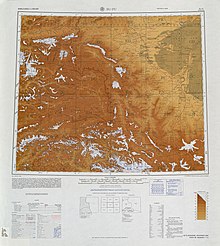Mai-kai-t'i
Appearance
English
[edit]
Alternative forms
[edit]- Maikaiti (also from Wade–Giles)
Etymology
[edit]From Mandarin 麥蓋提 / 麦盖提 (Màigàití), Wade–Giles romanization: Mai⁴-kai⁴-tʻi².
Proper noun
[edit]Mai-kai-t'i
- Alternative form of Maigaiti (“Makit”)
- 1949, SINKIANG IRRIGATION AND FACTORY PROBLEMS DISCUSSED; FARM LOANS TO BE DISTRIBUTED[1], page 1:
- Mai-kai-t'i Hsien in the western sector of the Takla Makan Desert urgently needs to solve its long-standing irrigation problem and make its arid soil more productive.
- 1964, T. SD., “YARKAND”, in Encyclopedia Britannica[2], volume 23, →OCLC, page 877, column 2:
- Upon emerging from the Kunlun gorges, the Yarkand loses the characteristics of a raging mountain torrent and spreads out in many branches over an alluvial fan to irrigate the Yarkand oasis. The oasis, one of the largest in Sinkiang, contains the towns of Yarkand (So-ch’e) and Tse-p’u (Posgam). Upon leaving the Yarkand oasis, the river flows north past Mai-kai-t’i (Merket-Bazar) and then northeast around the eastern margins of the Takla Makan desert. South of the Aksu oasis it joins the Kashgar, Aksu and Khotan rivers to form the Tarim.
- 1976, Chuen-Yan David Lai, “Developments of Cotton Cultivation in Sinkiang”, in Pacific Viewpoint[3], , →ISSN, →OCLC, page 162:
- In the western part of the Tarim Basin, cotton is grown mainly between the K'a-Shin-ka-erh (Kashgar Darya) and Yeh-erh-ch'iang (Yark and Darya) rivers where the growing season is longer and population denser. The main centres are K'a-shih (Kashgar), Pa-ch'u, Yüeh-p'u-hu, Mai-kai-t'i (Merket), So-ch'e (Yarkand) and Tse-p'u (Posgam).
Translations
[edit]Maigaiti — see Maigaiti
